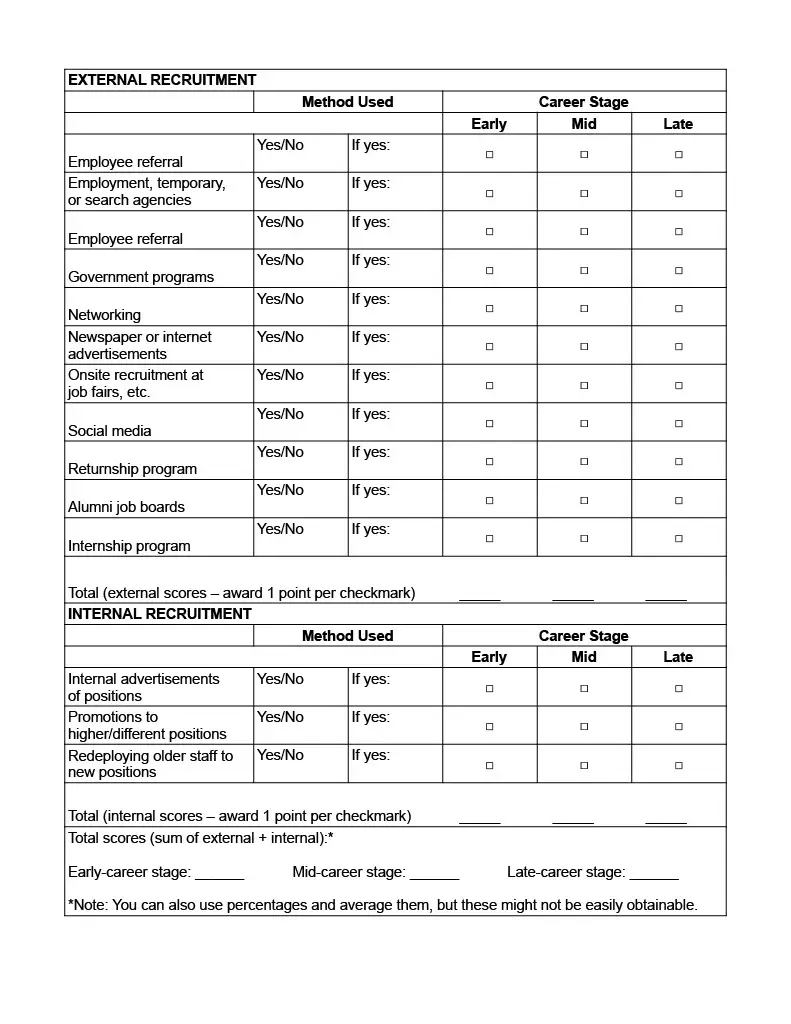Age-Inclusive Hiring for Social-Impact Organizations Tip Sheet

Studies show that age diversity is good for business; it’s proven to boost productivity, reduce costly employee turnover, and increase profitability. Additionally, when leveraged correctly, age diversity can increase knowledge sharing and innovation.
The labor force is already age-diverse—with as many as five generations represented—but are you doing enough to attract candidates of all ages to your organization? If you haven’t thought intentionally about this topic before, it’s a good idea to lay some foundational support before implementing specific tools and strategies:
- Include age diversity in your organization’s strategic goals and outcomes by considering how you’ll leverage age diversity to address competitive challenges, skills gaps, or threats to programmatic continuity. For example, if growth is a strategic goal, bringing in a seasoned leader to build organizational structure and oversee change management efforts could help keep the wheels turning smoothly. Or if upskilling is a key concern, consider pairing older and younger workers to learn new skills from each other.
- Identify, recruit, and designate an executive sponsor to provide support at the leadership level, especially if a focus on generational diversity is a newer concept for your organization. Look for a champion with genuine affinity for your organization’s mission. For example, consider how you might recruit older professionals to join your board or attend events. And don't stop there! How might you ensure that engagement is happening across age divides?
- Include age in your Diversity, Equity, and Inclusion (DEI) initiatives. What does not get measured does not get done. Including age as an element of DEI efforts provides an anchor for the work of age inclusion even if you start small. One good way to signal your commitment to age diversity is to sign the AARP Employer Pledge, joining over a thousand companies who have done so since 2012.
With your strategic framework laid, you can make practical changes to attract workers of all ages to power your social mission. Revisit your hiring process, widen your sourcing pool, and above all, don’t forget to communicate your mission and values:
- Audit your application process and remove graduation dates. Be transparent about the salary range in your job description to allow candidates to decide whether or not the range meets their needs.
- Audit your job description to remove any words that send subtle messages that older workers are not welcome; reference the guide Say This, Not That for an age-friendly word bank.
- Represent age as an element of diversity in branding materials including websites and social channels. Get descriptive on your website about your organization’s culture, values, and benefits. Acknowledge age as an element of diversity and when possible, show different generations in imagery or illustrations.
- De-bias your interview process with scripted questions and a scoring system for assessing behavioral and interpersonal skills. When possible, conduct blind interviews by removing demographically identifiable information from the resume. If you cannot afford software, try exporting submissions and hiding columns with demographic markers.
- Select your interview panel carefully. Ensure that your interview panel reflects your diversity values and the community you serve. Expand your criteria of interviewers beyond the technicalities of the role. Each panelist can bring a different experience to the table, including workplace culture, life stage experience, shared interests and more.
- Shift requirements from degree-based to a hybrid of credentials. Include experience and skill set as qualifying factors in a hiring decision, not solely degree programs. Candidates from multiple backgrounds cannot be expected to share the same experiences or skill sets.
Take a moment to assess your previous sourcing strategies according to career stage. Utilizing affinity or demographic-specific platforms helps improve the quality of candidates you are sourcing. If your sourcing strategies did not yield an age diverse workforce, consider eliminating or expanding some recruiting platforms.
Use our tool to explore how your efforts to recruit age-diverse candidates are fairing across different platforms and methods: Recruiting Age-Diverse Candidates Across Platforms
Focusing on age-inclusivity doesn’t end with this checklist. Once your organization has implemented some of our tips, schedule reflection touchpoints to review results and progress, solicit feedback, and reevaluate age-inclusivity-focused organizational goals on an ongoing basis.
And remember, AARP and Idealist are always available as resources to inform your strategic plan for age-inclusivity.







